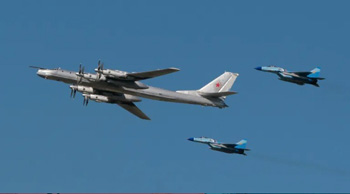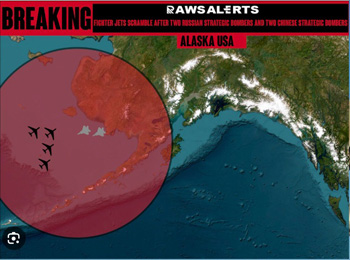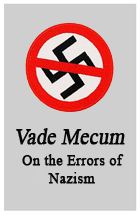International Affairs
 |
 |
 |
 |
 |
 |
 |
Russian Warplanes Fly Near Alaska Airspace
- Russian nuclear-capable bombers and fighters were intercepted by U.S. and Canadian jets near Alaska in the ninth such incident this year.
- Trump urges NATO to intensify Ukraine support, shifting from negotiation calls to a more aggressive stance against Russia.
- Russian aerial incursions into NATO airspace in Poland, Romania, and Estonia are seen as deliberate tests of alliance unity.
- NATO warns it will use all means to defend against violations, while Russia claims NATO is directly fighting against it.
- Escalating tensions raise fears of miscalculation, with Pompeo warning of potential nuclear escalation if provocations continue.

Two Russian bombers escorted by jets were intercepted at the identification airspace of Alaska
This was the ninth such interception this year and the third in just one month, according to NORAD. While the command downplayed the event as routine, the timing is far from coincidental. It follows Trump’s recent statement on Truth Social, where he declared that Ukraine – with NATO’s financial backing – could “fight and WIN all of Ukraine back in its original form.” His remarks signal a shift from earlier calls for Kyiv to negotiate concessions, instead urging a more aggressive stance against Russian aggression.
A pattern of provocation
The Alaska interception is just one piece of a broader pattern of Russian aerial incursions into NATO airspace. In recent weeks, Russian drones and warplanes have violated the skies of Poland, Romania, and Estonia – each time testing the alliance’s resolve. On September 10, more than a dozen Russian drones entered Polish airspace before being shot down, prompting Prime Minister Donald Tusk to warn that his country was closer to armed conflict than at any time since World War II. Three days later, Romanian airspace was breached by another Russian drone, followed by an unprecedented 12-minute incursion by three Russian MiG-31 fighters into Estonia.
Russian officials have denied deliberate violations, but analysts suggest otherwise. Natia Seskuria, an associate fellow at the Royal United Services Institute (RUSI), told The Independent that these incursions are “deliberate” and designed to probe NATO unity. “Putin is basically testing a Western response,” she said, adding that the Kremlin is signaling its willingness to escalate unless it secures favorable terms in any peace negotiations.
Trump’s warning and NATO’s dilemma

Graph of the Russian warplanes near Alaska
The Kremlin, for its part, has framed NATO’s support for Ukraine as direct involvement in the war. “NATO is providing direct and indirect support to the Kyiv regime,” Kremlin spokesperson Dmitry Peskov told reporters. “It can be said with absolute certainty that NATO is fighting against Russia.”
A dangerous game of brinkmanship
The Alaska interception, while not an immediate threat, serves as a reminder of how easily tensions could spiral. Russian warplanes have long tested U.S. defenses in the region, but the frequency of these incidents, coupled with drone strikes in Europe, suggests a calculated strategy to destabilize NATO’s eastern flank. Denmark’s recent drone incursions, which shut down major airports, further highlight the risks. Danish Prime Minister Mette Frederiksen hinted at Russian involvement, though Moscow denied responsibility.
Former Secretary of State Mike Pompeo has warned that such provocations could push Putin toward an “extreme” response, including nuclear escalation. With Russia and Belarus conducting joint military drills – often a prelude to real-world aggression – the potential for miscalculation grows.
For those paying attention, the message is unmistakable. The Russian regime is not backing down, and neither is NATO. With each interception, each drone strike, and each bold statement from world leaders, the risk of a wider conflict inches closer.
Read other articles by Cassie B. here
Posted October 1, 2025

______________________
______________________








